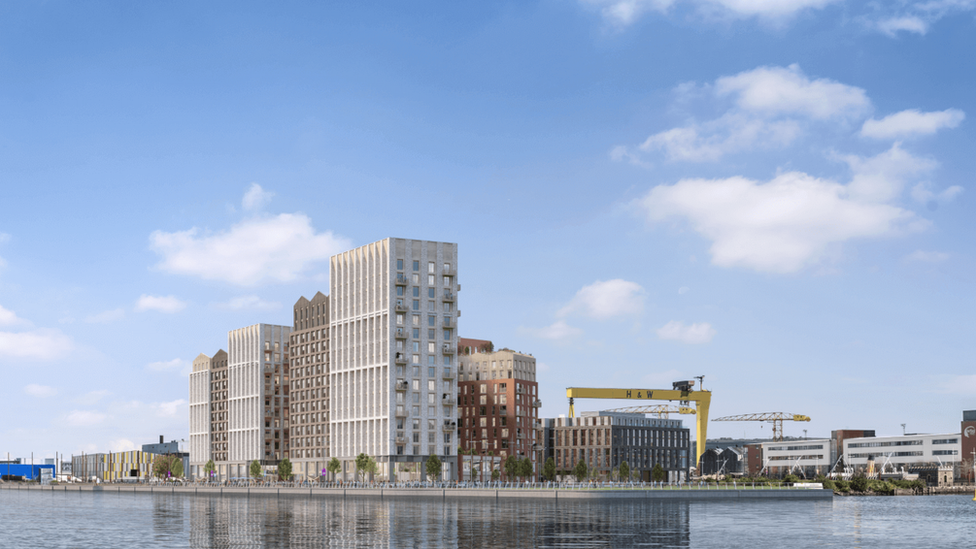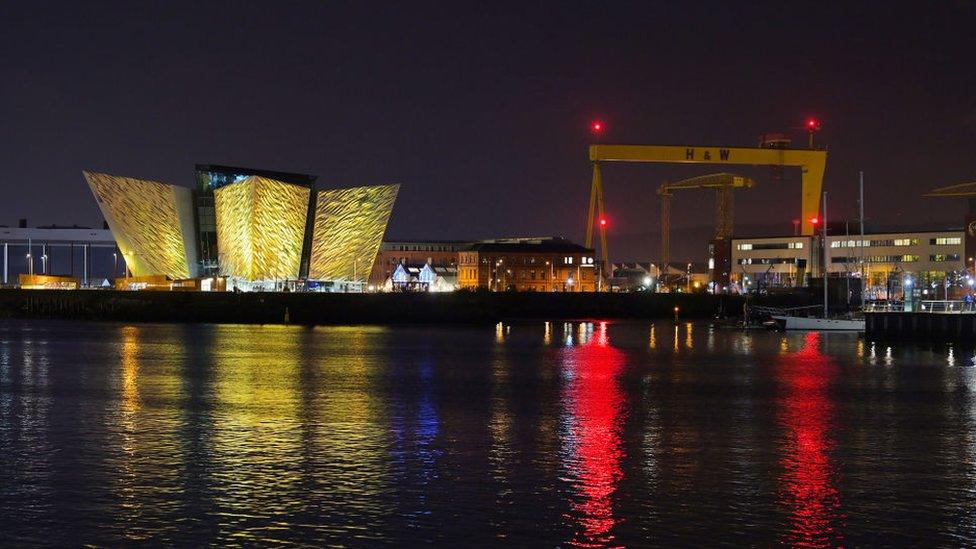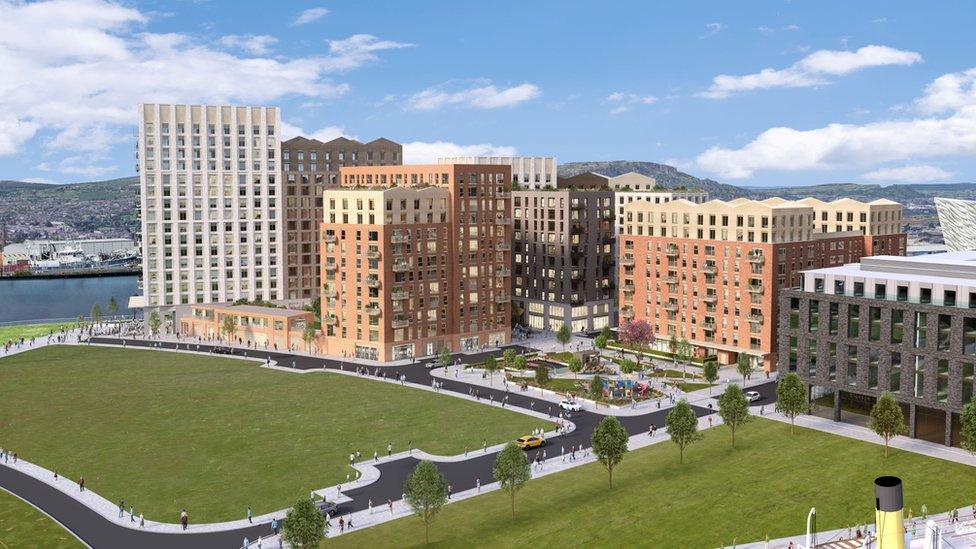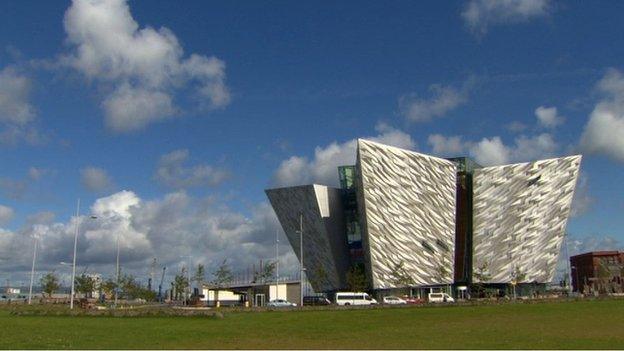Loft Lines: Fears towers will block Belfast's Titanic building
- Published

More than 700 homes will be built at the Loft Lines development on Queen's Island
The building of 778 new apartments in Belfast's Titanic Quarter could cause "lasting damage" to the city's skyline, the deputy lord mayor has claimed.
The Loft Lines development got planning permission last year, despite concerns it will block "key views", including that of the Titanic Belfast building.
Deputy Lord Mayor Áine Groogan objected to the height of the tower blocks and raised concerns about flooding risks.
But the developers said it would boost the economy and address housing needs.
Loft Lines is a three-block apartment development located at Queen's Island in the docks area of the city, on land which used to form part of the Harland and Wolff shipyard.
Construction of the tower blocks began last week, on what has been billed as Northern Ireland's first build to rent (BTR) housing scheme.
The majority of the 778 apartments will be privately owned and rented out to tenants, but up to 20% of the properties will be constructed as social, affordable homes.
The Queen's Island site is beside one of Northern Ireland's most successful tourist attractions - Titanic Belfast.
Concerns have also been raised that the new tower blocks will obscure views of the Harland and Wolff cranes for many residents.
Ms Groogan, who represents the Green Party at Belfast City Council, told the BBC's Talkback programme that she "raised serious concerns" about the Loft Lines proposal during last year's planning process.
"I know there were significant concerns from our senior urban design officers who raised the issues - blocking those key views," she said.
"This could have real, lasting damage to the skyline of Belfast and that's really concerning that people didn't take that into consideration, didn't think that was serious enough."

Images of Titanic Belfast and the Harland and Wolff cranes are often used to promote Belfast
The deputy lord mayor also said she highlighted flood risks at the riverside location during council meetings last year.
"The Rivers Agency were clear to us that it didn't meet the required standard," Ms Groogan added.
She also told the programme that she was not satisfied with the quality of the social housing units in the proposals, compared to the private homes.
Despite her objections, the application secured the support of enough councillors to be granted planning approval in April 2022.
Other critics have questioned the lack of car parking provision, but developers said their site prioritises pedestrians and cyclists over the use of cars, which would help to reduce Belfast's carbon footprint
Supporters of the riverside development expressed hope it will also help to address long-term housing need in Belfast.
Allow X content?
This article contains content provided by X. We ask for your permission before anything is loaded, as they may be using cookies and other technologies. You may want to read X’s cookie policy, external and privacy policy, external before accepting. To view this content choose ‘accept and continue’.
"What has marked Belfast out, for many years, is that we have not built enough homes in the city centre," said Grainia Long, chief executive of the Northern Ireland Housing Executive (NIHE).
"We need to be building communities in the city centre and those communities will improve everyone's lives.
"They'll give us schools in the city centre; they'll give us new types of public services."
'It looks like a crashed rocket'
The Ulster Architectural Heritage organisation has concerns about the lack of water treatment and sewage infrastructure at the site.
Its vice-chair John Anderson told Talkback that planners approved the project in spite of warnings from water authorities.
"It's the classic cart before the horse," he said.
"The practical fact is, if you put these buildings up and you fill them with people going to the toilet, you cannot connect to a main sewer because there is no way of treating the water."
Mr Anderson admitted he was personally "not a fan" of the Titanic Building, which opened to the public in 2012.
"To me, it looks like a crashed rocket," he joked.
"Our primary concern is heritage buildings - not particularly the Titanic building itself because it, as yet, is not a heritage building."
However he did express reservations about the effect on other historically significant sites in the area, including the cranes, the Drawing Office and the dry dock.
"Developers always punt this as: 'Oh, this is reflective of Belfast's historic past.'
"No, it overshadows Belfast's historic past," Mr Anderson argued.

The plans include a one-acre park for residents and visitors
The tower blocks will be located on the site of Harland and Wolff's former Mould Loft - a large room where designers known as loftsmen sketched out life-size drawings of ships.
This influenced the name of the new building and the Loft Lines developers have acknowledged they must "understand and respect the past".
The social housing units of the Loft Lines development will be managed by the Clanmill Housing Association.
However, the NIHE is supporting the project and its chief executive said she will ensure Clanmill can access grants to fund the construction.
Ms Long was among those who attended the breaking ground ceremony at the building site last week.
She explained the Loft Lines development is part of a wider, 10-year-old masterplan which proposed 5,000 new homes in the Titanic Quarter alone.
"For Belfast to thrive, we need a generation of beautiful homes to house people in need, and to house people in need in a way that we are living our lives together, so real genuine links," she said.
The lead developers of the site are Lacuna Developments and Watkin Jones Group PLC, while Belfast Harbour and Titanic Quarter Limited are described as key stakeholders.
The developers are acting on behalf of Legal and General Investment Management and Clanmil Housing Association who signed a "forward funding" deal with the companies in June.
Forward funding means the investor funds construction and then takes control of the completed scheme.
BBC News NI has asked Lacuna Developments to respond to the concerns raised.
Related topics
- Published5 June 2023

- Published15 April 2022

- Published2 December 2016
